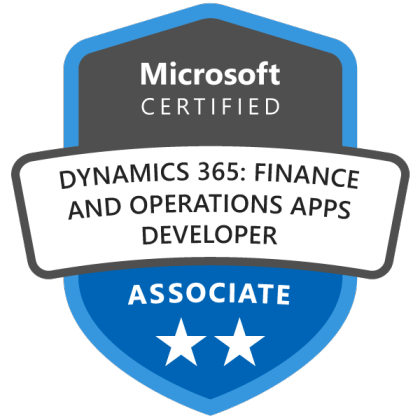MB-500: Microsoft Dynamics 365: Finance and Operations Apps Developer
Welcome to the MB-500: Microsoft Dynamics 365: Finance and Operations Apps Developer course! In this course we discuss the tasks needed to fulfill the role of developer in Dynamics 365 Finance and Operations Apps. The Dynamics 365 for Finance and Operations (FO) developer is a key technical resource that implements and extends the application to meet the requirements of the business. The Microsoft MB-500: Microsoft Dynamics 365: Finance and Operations Apps Developer course is a developer training course used to implement and extend the applications within the software suite to meet the requirements of an organization. The MB500T00-A course equips candidates with the ability to provide fully realized solutions using standardized application coding patterns, extensible features, and external integrations.Professionals will be able to customize Finance and Operations applications to offer organizations the ability to craft unique solutions better suited to a business on a case-by-case basis.
Microsoft Courseware
Instructor-Led Training
Course Duration: 5-Days (40-Hour)
Microsoft Official Lab Exercises
Courseware Life Time Free Upgrade
Cloud Lab Access
Overview
This course discusses the general capabilities of the Microsoft Dynamics 365 suite of finance and operations apps, including built-in reporting and integration with other Microsoft products such as Microsoft Excel, Microsoft Word, Power BI, and Microsoft Teams.
Dynamics 365 offers a large range of cloud-driven applications that help organizations optimize their business so they can reach their full potential. This module explores the Dynamics 365 ecosystem and how the apps work together to help your organization reach its fullest potential. Additionally, this module describes the major components of finance and operations apps that are important for you to know before you begin developing.
Modules
Module 1: Overview and architecture
- Explore the ecosystem and main components
- Explore the technical architecture
- Explore design and deployment considerations
Module 2: Developer Tools
- Manage implementations by using Lifecycle Services
- Manage source code by using version control
- Customize by using Visual Studio
Module 3: Solution Design
- Implement application lifecycle management
Module 4: AOT Elements
- Build extended data types and enumerations
- Build tables
- Build forms and optimize form performance
- Create classes
- Create other user interface elements
Module 5: Code Development and Testing
- Explore the test framework and use tools
- Get started with development using X++
- Develop object-oriented code
- Use RSAT tool
Module 6: Data Migration
- Prepare data for migration
Module 7: Frameworks
- Introduction
- Explore extensions and the extension framework
- Extend elements
- SysOperationSandbox framework
Module 8: Integration
- Identity data integration patterns and scenarios
- Implement data integration concepts and solutions
- Implement the Data management package API
- Data integrations
- Integrate with Microsoft Azure
- Connecting to Power Platform services
- Consume business events
- Integrate Finance and Operations apps with Microsoft Dataverse
Module 9: Reporting
- Explore the reporting tools
- Build reports
- Build workspaces
- Manage data sources with external data stores
Module 10: Security and Performance
- Work with performance and monitoring tools
- Implement role-based security
- Apply basic performance optimization technique
Fees And Schedule
Instructor-Led Training
40-Hour of Instructor-Led Training One to one doubt resolution sessions Microsoft Official Lab AccessLearning Objectives
After completing this course, students will be able to:
- Discover the suite of finance and operation apps that you can use for enterprise resource planning.
- Review use cases for finance and operations apps.
- Learn about the main components of finance and operations apps.
- Learn about on-premises and cloud deployment options.
- Explore the development and deployment process for finance and operations apps.
- How Microsoft helps customers upgrade.
- Architectural and operational differences between AX 2012 and finance and operations apps.
- Learn about the purposes and relationships between packages, models, and elements.
- Learn about the application components and architecture.
- Detail metadata management and source control processes.
- Use and understand the purpose of Lifecycle Services.
Reviews

Dipak Agarwal - Business Analyst at Genpact
Excellent professional & comfortable environment to learn
The training was good, I would like to go through some more training.

Gurpreet Marwaha - IAM Analyst at National Australia Bank, Australia
I learned a lot
Excellent Office 365 training provided by Flexmind

Praveen S (Associate at Grant Thornton LLP)
Excellent knowledge of the trainer on the Subject
I attended PowerApps/Flow training from Flexmind. The topics of the course were well organized & knowledge of the trainer on the subject was excellent. It was very helpful and I will apply in my day to day task at the office. I will definitely recommend a friend or colleague to attend courses from Flexmind.
